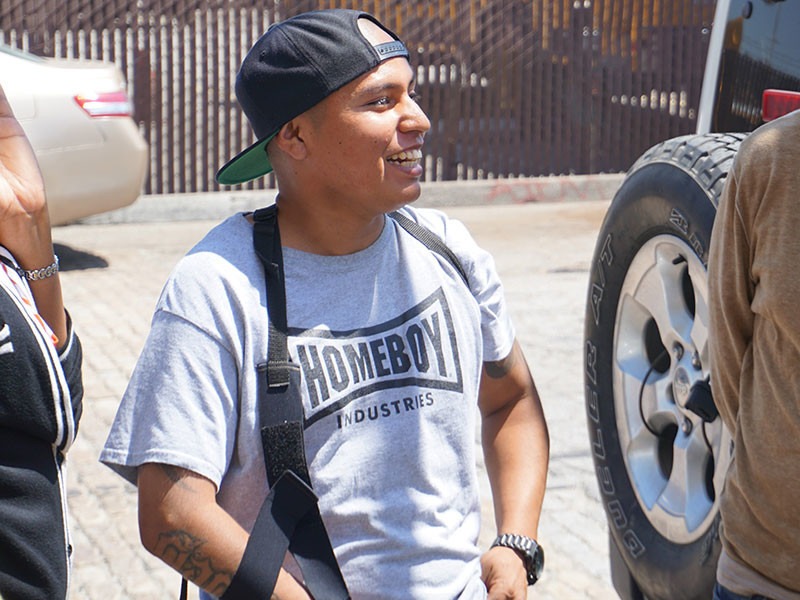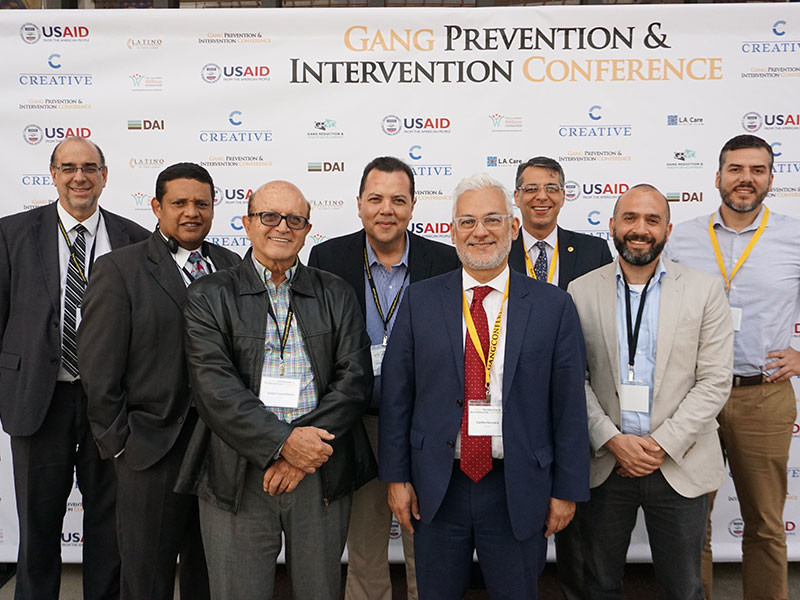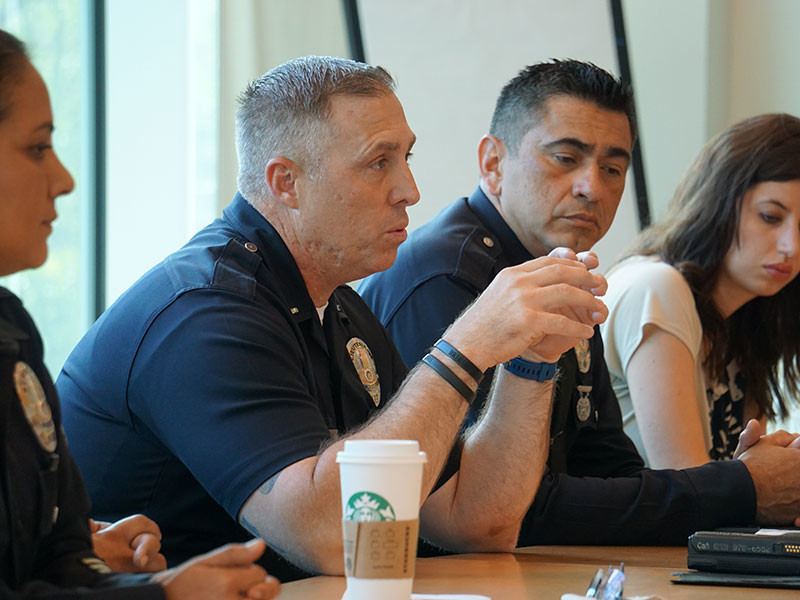Looking at LA’s violence prevention through a Salvadoran lens
By Evelyn RupertMay 16, 2018
Study tour gives leaders and practitioners from Central America insight into Los Angeles’ efforts to stem violence
LOS ANGELES – It’s a Wednesday afternoon and Homeboy Industries is bustling with people who have made the decision to leave the gang their lives once revolved around. For Omar, it took several one-month stints at Homeboy and six gunshot wounds before he committed to the 18-month rehabilitation program and restarted his life.
He has now been a tour guide for five years, explaining Homeboy’s work to support former gang members to reintegrate into society and showing visitors around its facilities, which include a restaurant and café, shop, bakery, classrooms, free tattoo removal clinic and more.
It is one of several stops for a group of about 30 people, most visiting from Central America, came to Homeboy as part of a three-day study tour of Los Angeles’ programs and agencies committed to reducing violence. The tour followed the annual Gang Prevention and Intervention Conference, which was held May 7-8.
Speakers, panelists and site visits gave conference attendees an in-depth look at work being done in Los Angeles, from family services for youth at risk of joining gangs to reentry support for former gang members who are exiting prison.
For attendees from countries with high levels of gang violence, such as Honduras, Guatemala and El Salvador, the conference and study tour was an opportunity to see the intricacies of violence prevention and intervention in L.A. and consider ways to adapt the work in their home countries.
The study tour was co-sponsored by Creative Associates International, which implements several crime and violence prevention projects in Central America, in partnership with Southern California Crossroads.
In this Q&A, Jaime Zablah, president and CEO of the San Salvador rehabilitation program Factoria Ciudadana, and Héctor Abel Tobar, El Salvador National Police Sub-Commissioner, share some of their reflections on the tour and their hopes for violence prevention back home.

What interested you in your line of work and in violence prevention specifically?
Jaime Zablah: Last year, I came here to the same conference and to Homeboy Industries. That’s exactly when I decided that we had to do something. I’ve been working in this field for 12 years, but the conference last year was a turning point, or a reflection point. I saw that it was possible to get people out of gangs, and not only through jail. I saw that what they need is work, and they need care and they need somebody to come up and say, ‘Hey, you’re worth it, you’re worth fighting for.’
Abel Tobar: I have been in the police force for more than 20 years, but I have spent about eight years working on a project to change the philosophy in law enforcement, to move toward community policing, community outreach and a police force with a strong prevention component sothat the police leave behind the idea of 100 percent repression and focus on generating trust with the communities.
Both of you have attended the Gang Conference in years past. What made you want to come back this year and participate in the study tour?
Zablah: You see things in L.A. and you realize that there’s a lot missing in El Salvador. And so you start trying to implement some of the things you saw. But there’s always something new to learn. This time, for example, we got to visit Amity Foundation and talk to people who are finishing their sentences and see how they can be rehabilitated before and right after they get out of prison.
Tobar: I think that for me it’s important to get to know a little bit more about the preventative programs that directly relate to gangs in El Salvador. In El Salvador, gangs are a serious problem. And what often gets in the way of police reaching out to the community is exactly that gang presence. So it’s important to see the preventative programs and the programs that have helped with that issue here.

What part of the study tour stood out to you the most?
Zablah: I always have a great experience talking with former gang members, because you learn from them. Someone said this week that the best way to learn is not to sit at your desk but talk to your clients. For me, that’s something that I’m always going to remember. The visit to Amity really impacted me. And it’s a dream, it’s something we have to reach for. But I hope to come back soon and visit them again.
Tobar: For me, the most memorable thing is just to see the different stages of prevention. In El Salvador, there is not much work being done in tertiary prevention and rehabilitation of people who have been detained. Having that experience here was really great, and I think we should start doing that type of work in El Salvador. What also caught my attention was when Richard Ramos from Parents on a Mission said that when a garden isn’t growing, you don’t talk to the flowers, you talk to the gardener – meaning that you need to work with the parents in order for their kids to flourish. It’s important to work with youth, but we also have to shift our perspective to see that problems with kids often start in the home.
What are your hopes and what challenges do you see in translating some of the work being done here in L.A. to El Salvador?
Zablah: When I came last year, I thought starting something like Homeboy in El Salvador was a dream. But then we opened the doors to Factoria Ciudadana. The hardest thing is getting people to understand the concept of Homeboy when they have not been here, it’s transmitting what I’m seeing to my staff. For example, the psychologist that works with me thinks that everyone has to have an appointment and then they have to leave the foundation. And after seeing some of the programs here, I’m saying no, they should be able to stay the whole day and I’ll give them breakfast and lunch and a library.
What I think can be done as perhaps a second project would be something like Amity. I think it can be done, creating a therapeutic community and helping people get jobs. That’s my goal.
Tobar: I think one of the limitations is just the Salvadoran context, in terms of the gangs, in terms of the population, in terms of the stigma. Even the laws have to change for us to be able to implement some of the programs that they have here. And we would have to adapt them to the characteristics of our countries.
We’d have to work with the population, work with the politicians and work even within the police force to put in place programs that would rehabilitate gang members and change mindsets.
But I think that we can do it. It will take a lot of work, but we can get there. And I’ve always said that more elected officials, more leaders, more community actors, private sector folks and police should come to events like this so that we can change the thinking that exists now.

Thank you to the agencies and organizations that participated in the study tour:

